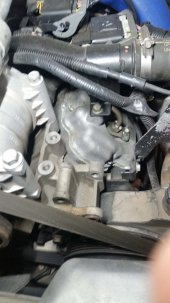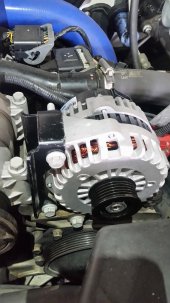I'm testing charging right now, using the cheapest Chinese DC to DC boost converter I saw on Amazon which had:
1. A substantial heatsink.
2. Voltage adjustment _and_ current limiting adjustment.
But not direct from the alternator. I'm boosting 12V (from a backup battery) up to about 30V and connecting it through a heavy duty Schottky diode to the solar controller's panel input, in parallel with my 2X2 series/parallel array of 12V panels. It's only a couple of amps at 30V (more at 12V, of course. Something like 5A, I estimate, although I blew a 7.5A fuse yesterday morning), but hat's enough for me, because I figure that adding load to the alternator means charging batteries with energy from (incrementally) expensive gasoline, as with a generator, except not as efficiently as with a generator, instead of (incrementally) free solar. There are a couple more tricks yet to be added, like a low voltage cutoff board, which cuts it off when the battery drops too low (that's going to be just a little under 13V, I expect), and maybe connecting it to a circuit which is switched by the ignition, probably through a relay). And putting it in a box. Also I will switch, when the panels have fully charged the house batteries, to trickle charging all the 12V batteries via buck converters (to save money on generation costs, and keep the batteries healthier). I think I have all the boards in a box (except the ones I'm already testing with) where I put them after searching them out and ordering them from Amazon, here and there, over the last few months.
The way it is right now, the 24V house batteries trickle charge the backup and starter 12V batteries all the time, except, currently they are a test pack, which is much too small to do that all night _and_ make tea in the morning, before the sun comes up, so I disconnect the trickle charge and connect the boost converter until there is enough stuff to run my electric kettle without the inverter going into low voltage cutoff prematurely, due to voltage sag. Then, since I don't have the panels attached yet, if I'm going somewhere, I leave the boost converter on and let the alternator charge it, otherwise, add the panels, disconnect the boost, and reconnect the buck converter, to charge the 12V batteries back up.
One more thing. Maybe you don't want the _cheapest,_ the one with the largest heat sink I found arrived with electrolytics which had dented cans, Amazon gave me credit, so I bought another, and _it_ has dented cans, and they look like crap capacitors anyway, so I ordered decent ones from distribution, which cost more than the price of the converter, plus, my time to do all that is much more, plus my time to replace the caps when I get around to it (hopefully before one of them pops) is much more, so, I've invested in education (especially if one pops before I get around to replacing it) which I'm now spending non-billable hours sharing here.
And, I guess you could get "free" power from the alternator, if you charged batteries only when decelerating, or descending a hill using engine braking on trips you would have taken anyway. And, save your brake pads!




